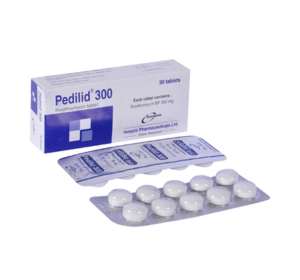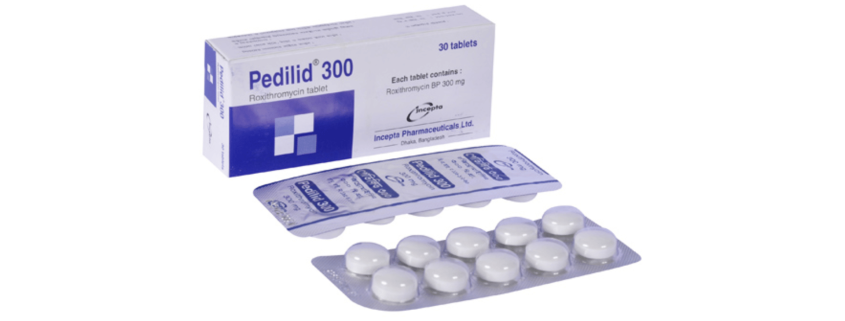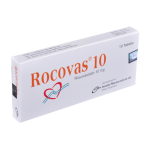Pedilid(Roxithromycin)

Therapeutic Group: Anti Bacterial
Presentation
Pedilid 150: Each film-coated tablet contains Roxithromycin BP 150 mg.
Pedilid 300: Each film-coated tablet contains Roxithromycin BP 300 mg.
Pedilid powder for suspension: When reconstituted each 5 ml suspension contains Roxithromycin BP 50 mg.
Description
Roxithromycin, is a macrolide with antibacterial properties similar to erythromycin. It is active against Gram-positive bacteria like staphylococci, streptococci, listeria, corynebacteria; Gram-negative bacteria such as gonococci, Haemophilus influenzae, Haemophilus ducreyi, Legionella, campylobacter, and atypical pathogens like Mycoplasma and Chlamydia. Roxithromycin has been found useful in the treatment of upper and lower respiratory tract infection, otorhinolaryngological, skin, dental and genital infections. It is well tolerated by adults and children.
Indications
Roxithromycin is indicated in the treatment of infections caused by susceptible microorganisms;
Respiratory infections like pneumonia, acute and chronic bronchitis, and bronchopneumonia
ENT infections like tonsillitis, pharyngitis, sinusitis and otitis media.
Skin infections like folliculitis, furuncles, cellulitis, carbuncles, pyoderma, impetigo and infected dermatitis.
Genital infections like urethritis, prostatitis, cervicitis and salpingitis especially if produced by Chlamydia trachomatis.
Dosage & Administration
Adult dose: The usual dose for adults is one 300 mg tablet once daily or one 150 mg tablet twice a day for at least two days after resolution of symptoms, a normal course of therapy is between 5 and 10 days. Roxithromycin is best administered on empty stomach. In severe hepatic impairment the dose is 150 mg once daily.
Paediatric dose: The dose for children is 2.5 to 5 mg/kg body weight twice a day. The following general guidelines can be followed
6 to 11 Kg: 25 mg Roxithromycin 12 hourly.
12 to 23 Kg: 50 mg Roxithromycin 12 hourly.
24 to 40 Kg: 100 mg Roxithromycin 12 hourly.
A normal course of therapy is between 5 and 10 days.
Side Effects
Roxithromycin is well tolerated by patients of all age groups. Less than 4% of treated patients complain of side effects mainly nausea, abdominal pain, diarrhoea and hypersensitivity rash. Other side effects reported include vomiting, dizziness, headache, pruritus, dyspepsia, flatulence, tinnitus, vertigo and constipation. These are in general minor and do not necessitate withdrawal of therapy.
Precautions
Roxithromycin should not be used in patients with a history of hypersensitivity to the drug. In patients with hepatic diseases the dose of Roxithromycin should not exceed 150 mg twice a day.
Use in Pregnancy & Lactation
The safety of Roxithromycin in pregnancy has not been established. It appears in breast milk in small amounts and dose not produce adverse effects in the breast fed infant.
Drug Interaction
Roxithromycin does not have any affinity for cytochrome P- 450 binding sites and thus is unlikely to produce drug interaction mediated by this enzymatic system. Roxithromycin shows mild interaction with theophylline though this has not been found to produce clinically relevant effects. Alteration in the pharmacokinetics of carbamazepine or warfarin has not been found. Antacids, H2- receptor antagonists and food has no effect on the absorption of Roxithromycin.
Commercial Pack
Pedilid 150: Each box containing 5 blister strips of 10 tablets.
Pedilid 300: Each box containing 3 blister strips of 10 tablets.
Pedilid powder for suspension: Bottle containing Roxithromycin powder to produce 50 ml suspension.
Others
Roxithromycin is well absorbed on oral administration and achieves plasma and tissue concentrations well above the minimum inhibitory concentrations for susceptible microorganisms. Effective bactericidal concentrations are found in tonsils, pharynx, adenoids, paranasal sinuses, bronchi, sputum, skin, gums, prostate and gynaecologic tissue. Mean peak plasma concentrations of about 7 mcg/ml are found 1.5 hours after an oral 300 mg or 150 mg dose of Roxithromycin. Roxithromycin has a mean plasma half-life of 9 to 16 hours and once or twice daily dosing is sufficient to maintain adequate bactericidal activity in plasma and tissues. It is metabolized by the liver to inactive metabolites. Excretion occurs mainly through feces and also through respiratory tract and urine. The plasma protein binding varies from 30 to 50 percent. Roxithromycin pharmacokinetics is similar in infants, children, adults, and elderly. Accumulation does not occur in patients with compromised renal function and dosage adjustment is not necessary. In patients with severe hepatic dysfunction the elimination half-life is prolonged and a dose of 150 mg twice a day should not be exceeded.



